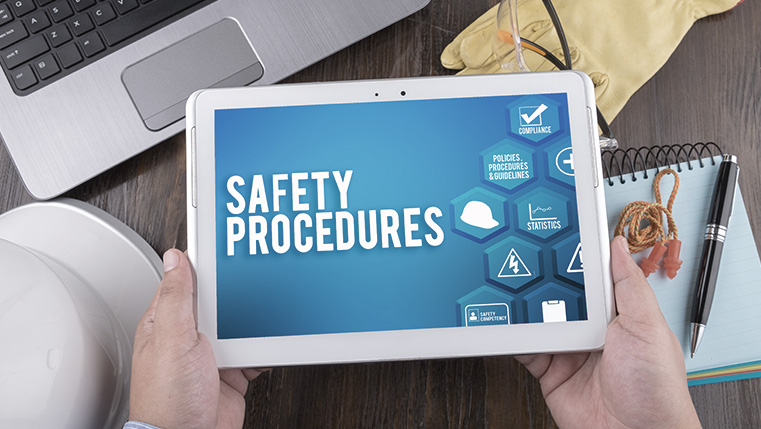Can Safety Training Be Taken Seriously If It’s Online?

Although mandatory, rarely does safety training take precedence over leadership training or whatever training is required, by an individual, to climb the corporate ladder. Is this sheer stupidity on the part of humans? Is it our addiction to always ride the “ragged edge of disaster” that makes us take safety training lightly? Perhaps it is just that our safety training programs are not exciting enough and are therefore a failure. What are we doing wrong? Is online safety training a solution?
What Are We Doing Wrong?
Several things. Firstly, we might not be bringing it to the attention of our employees, that failure to comply with safety measures is a serious offense – and one that can hurt not just the company, but individual employees as well.
Secondly, we know that safety training is a dry subject, and without any engagement, employees are prone to take a backseat.
Thirdly, safety training, like every other training, is forgotten over time; and when suddenly faced with a disaster, it is hardly possible to expect employees to remember all the steps involved in carrying out an emergency procedure they were introduced to several months ago, in a one-off training session.
Finally, employees just don’t have the time to take up a safety training – they believe they know how they can get themselves out of the building on fire or what to do when they chop off a finger in a machine, so they would use the little time they have, in ways they deem fit. This could be with family, doing a course that would help him climb the corporate ladder, or make more sales.
Why Online Safety Training?
Online training addresses the above shortcomings. For example, a short video or a case study can let learners know the importance of safety training; media-rich courses and interactivities can make an otherwise boring safety training course, engaging; Performance support, microlearning assessments, and refresher courses help with knowledge retention; and rapid development tools can rapidly create courses.
Online training can be accessed anytime, so long as there is access to an Internet connection. In fact, courses can be downloaded and played offline – making them accessible both offline and online – anytime and anywhere. Even assessments can be attempted in the offline mode and uploaded when Internet connectivity is available. Courses are also available on employees’ personal devices, and this alone will drastically reduce the number of excuses for not taking up training.
Online Safety courses are easy to develop. Some years ago, a client requested us to create interactive safety and wellness videos for a workshop to highlight the importance of safety and wellness at the workplace. We had only two weeks to create these interactive videos from scratch; and we did it! Read how we successfully created these quick videos, here.
Online safety training programs can be created with rich animations and images, and can be made interactive, providing engagement and enhancing one’s interest to take up and complete the course. Interactivities include videos, scenarios, and game-based learning.
As well as protecting one’s self and the company’s property from damage, there is another type of safety that is very important – and that involves keeping data safe. Unless learners are made aware of the consequences of a breach in security, this training won’t be taken seriously. Here is one such client that we helped.
Here is another case study of a client who required a course on the safety/security of data for its global workforce, in 9 languages. It’s possible to rollout uniform training to a global workforce, simultaneously across geographies, in multiple languages.
No matter how engaging or interactive a course, the human brain is prone to forget vital information, if this information is not reinforced regularly. Refresher courses that are not complete courses but a way of reinforcing important points of a previously conducted course is a necessity. It is possible to quickly-develop microlearning as refresher courses. Whether they are presented in the form of a video, assessment, game, or even just a voice recording, they are easy to create and very effective.
A bonus for trainers is that online safety training can be tracked. Certificates can be automatically issued to employees when they complete the course. Trainers are notified whenever an employee completes the course. Automatic reminders can be sent out to let employees know that they must complete the course.
Online safety training can be used for training employees on any type of safety issue including chemical hazards, ergonomics, safety hazards, and biological hazards in a stress-free, and safe environment.
Science has helped us understand natural calamities and to predict a tsunami, an earthquake, or any other natural disaster before it occurs. But it’s other living organisms – from the tiniest ants to the gigantic blue whale, who can sense magnetic disturbances from a distance, and respond to danger by doing whatever they need to do to keep safe. Unfortunately, we humans have no such ability. Even our sixth sense (if we have one at all), fails us in our hour of need. This is true of workplace safety as well – which makes it very important that we do it right, serve it right, and make it right for our employees.



![How to Design Effective Safety Training Programs with Rapid eLearning [Infographic]](https://blog.commlabindia.com/hubfs/blogs/rapid-elearning-safety-training-infographic.jpg)

![Tips to Boost Health & Safety Training with Simulations [Infographic]](https://blog.commlabindia.com/hubfs/blogs/simulations-in-health-and-safety-training-tips.jpg)